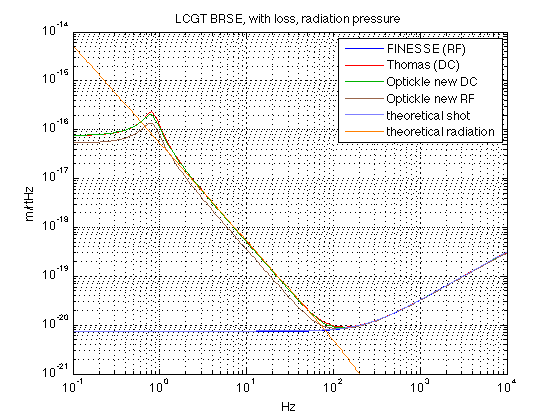|
Size: 2059
Comment:
|
Size: 2222
Comment:
|
| Deletions are marked like this. | Additions are marked like this. |
| Line 8: | Line 8: |
| ||e2e||C++||Time Domain|| ||Hiro Yamamoto||[[http://www.ligo.caltech.edu/~e2e/]]|| | ||e2e||C++, JAVA||Time Domain|| ||Hiro Yamamoto||[[http://www.ligo.caltech.edu/~e2e/]]|| |
| Line 11: | Line 11: |
| == Comparison of simulatio tools for LCGT == | == Comparison of simulation tools for LCGT == |
| Line 13: | Line 13: |
| I am comparing several simulation tools with theoretical line using LCGT 2007 parameters. I used here FINESSE, Thomas, Oprickle. Except for FINESSE, all results matched pretty well within 0.1%-1% accuracy. FINESSE seems to have a bug of a factor by sqrt(2), but it can be compensated later if you know this information. | Several simulation tools with theoretical line using LCGT 2007 parameters are compared here, FINESSE, Thomas, Oprickle. Except for FINESSE. |
| Line 15: | Line 15: |
| *Theoretical: just analytical way shown in LCGT document on page xx. *FINESSE: Developped by Andreas Freise. C based. 'ps2S' and 'scale meter' commands are used for the unit in m/rHz and 'fig' command are used to produce excitations in frequency domain. Compensation factor *sqrt(2) was needed to match other results. This could be a bug. *Thomas: Developped by Thomas Cobit. Visual C++ besed, running only Windows machine. This is the first simulation tool which can calculate quantum effect including raddiation pressure effect. For shotnoise calculation, just very hevy masses are used to compare shotnoise above. *Optickle: Developped by Matt Evans. Matlab based, very flexible simulation tool. You can use a full set of Matlab functions. This tool also can calculate full quantum effect. |
*Theoretical: just analytical way shown in [[http://gw.icrr.u-tokyo.ac.jp:8888/cgi-bin/DocDB/ShowDocument?docid=30|LCGT design document]] on page 14. *FINESSE: 'ps2S' and 'scale meter' commands are used for the unit in m/rHz and 'fig' command are used to produce excitations in frequency domain. FINESSE seems to have a bug of a factor by sqrt(2), but it can be compensated later if you know this information to match other results. *Thomas: Developped by Thomas Corbit. Visual C++ besed, running only Windows machine. This is the first simulation tool which can calculate quantum effect using two-photon modes. *Optickle: Very flexible simulation tool. You can use a full set of Matlab functions. This tool also can calculate full quantum effect. Optickel RF calculation seems to have a bug of a factor by sqrt(2) for the radiatoin pressure noise, but DC readout calculation is OK. This bug can be compensated to put 2*sqrt(2) instead of 2 on the setMechTF function but radiation pressure noise for DC readout will be larger by a factor of sqrt(2) in this case. |
| Line 21: | Line 21: |
| === FPMI no loss case with LCGT parameters === | |
| Line 23: | Line 22: |
| {{attachment:FPMI_noloss.png}} | Optickle uses vacuum injections from dark port and other lossy ports on this model due to introduce quantum noise, so Optickle result with RF detection is worse than other calculation like Thomas's DC readout. Calculation above this model assumed ideal flat shot noise, so all the results were matched well. |
| Line 25: | Line 24: |
| [[attachment:20090709_simall_FPMI_noloss.zip]] | === BRSE, with loss, radiation pressure noise for LCGT parameters === |
| Line 27: | Line 26: |
| === PRFPMI no loss case with LCGT parameters === | {{attachment:BRSE_loss_rad.png}} |
| Line 29: | Line 28: |
| {{attachment:PRFPMI_noloss.png}} [[attachment:20090709_simall_PRFPMI_noloss.zip]] === BRSE no loss case with LCGT parameters === {{attachment:BRSE_noloss.png}} [[attachment:20090709_simall_BRSE_noloss.zip]] |
[[attachment:20090930_simall_BRSE_loss_rad.zip]] |
Simulation Tools
Name |
Platform |
Domain |
Capabilities |
Author |
Web |
Optickle |
Matlab |
Frequency Domain |
Radiation Pressure, 01 mode |
Matt Evans |
|
Finesse |
C? |
Frequency Domain |
Higher order modes |
Andreas Freise |
|
e2e |
C++, JAVA |
Time Domain |
|
Hiro Yamamoto |
Comparison of simulation tools for LCGT
Several simulation tools with theoretical line using LCGT 2007 parameters are compared here, FINESSE, Thomas, Oprickle. Except for FINESSE.
Theoretical: just analytical way shown in LCGT design document on page 14.
- FINESSE: 'ps2S' and 'scale meter' commands are used for the unit in m/rHz and 'fig' command are used to produce excitations in frequency domain. FINESSE seems to have a bug of a factor by sqrt(2), but it can be compensated later if you know this information to match other results.
- Thomas: Developped by Thomas Corbit. Visual C++ besed, running only Windows machine. This is the first simulation tool which can calculate quantum effect using two-photon modes.
- Optickle: Very flexible simulation tool. You can use a full set of Matlab functions. This tool also can calculate full quantum effect. Optickel RF calculation seems to have a bug of a factor by sqrt(2) for the radiatoin pressure noise, but DC readout calculation is OK. This bug can be compensated to put 2*sqrt(2) instead of 2 on the setMechTF function but radiation pressure noise for DC readout will be larger by a factor of sqrt(2) in this case.
Optickle uses vacuum injections from dark port and other lossy ports on this model due to introduce quantum noise, so Optickle result with RF detection is worse than other calculation like Thomas's DC readout. Calculation above this model assumed ideal flat shot noise, so all the results were matched well.
BRSE, with loss, radiation pressure noise for LCGT parameters

